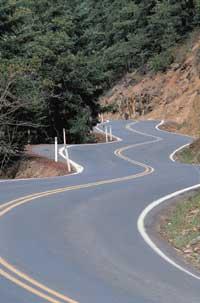Waterproof sheet: new bike
2007/04/01 Goikoetxeaundia Garmendia, Goretti - Kimikan lizentziatua Iturria: Elhuyar aldizkaria

So we can start this story. And we should continue to differentiate the different types of bikes. And, making matters more concrete, citing a specific type: natural asphalt bitumen. And then we should define how it is. It is a semi-solid/semi-liquid material, dark brown or black, adhesive and waterproof, coming from oil or natural asphalt.
In fact, natural asphalt bitumen is known since ancient times, as shown by archaeological remains. Up to 3,000 years before the birth of Christ, the Mesopotamian human being and the environment of the Indo river used in construction to fill the slits and unite the material. In Egypt he used it to embalming the corpses; in Sumer, to gear up or ship the ships.
The Bible does not define what kind of viké Noe used to make the ship, but by the time he wrote the book Home, the Jews knew about asphalt bitumen. The mother of Moses, in fact, "without being able to keep the children longer kept, took a basket of strapping and, with the grudges covered with galipón and geminado, brought the child" (Excursion, 2, 3).

The human being, to date, has used natural bitumen for centuries, both in construction and in other activities, with an increasing ability and taking advantage of the advances.
And the man created the tarmac curtain
With the development of the oil industry and the distillation of crude oil, man began to acquire numerous asphalt bitumen, because the subject that is obtained after the distillation of oil is that of full asphalt.
This asphalt bitumen came well for improving waterproof sheets. These plates were produced in the XVIII. In the twentieth century the coal galipot and fine sand are mixed. The coal galipot was replaced by asphalt bitumen.
XX. At the beginning of the twentieth century, the asphalt fabric impregnated with natural tissue in asphalt bitumen began to spread. In the middle of the century, natural fabrics were replaced by synthetic fabrics -- polymers in origin, such as polyester.

Therefore, from the 70's, the man took another step. Since then, it impregnates synthetic tissue in asphalt bitumen modified with polymers that improve the mechanical or viscoelastic properties of asphalt bitumen.
These last sheets are usually three layers, as can be seen in the attached figure. The central layer is a synthetic fabric -- polyesterra-edo--- that fulfills the support function, giving the plate a dimensional resistance. The other two are asphalt bituminous modified polymers that impregnate the central. Its structure is similar to that of a sandwich.
Today we have waterproof plates everywhere
Today we live surrounded by housing. And we have swimming pools, tennis courts, athletics, tunnels, artificial reservoirs and even artificial meadows. And in its construction the same hidden material is used: the waterproof sheet.

These plates, as indicated, are formed by asphalt bitumen and polymers to which polymer is added to improve their mechanical or viscoelastic properties. But not all types of asphalt bitumen are used to make waterproof sheets, nor all polymers to mix with asphalt bitumen.
In this way, a hard asphalt bitumen is used on the roads to withstand continuous changes in temperature and heavy vehicles. For the manufacture of waterproof sheets a softer system is used by adding a greater amount of polymers in the transformation process. The use of a hard asphalt bitumen in the manufacture of these plates would allow excessive viscosity of the mixture and would hinder the soaking of the polymeric support.
Polymers, on the other hand, must be compatible with asphalt bitumen to be completely mixed and, in addition, not degradable to the mixture with asphalt bitumen.
There are two types of polymers: unused and recycled. To improve the mechanical properties of asphalt bitumen, unused polymers are polypropylene, SBS copolymer (styrene butadiene-styrene) and polyethylene. However, in road paving works, the possibility of using recycled plastic from greenhouse plastic has been detected.
And in this context, our research work is framed. We are investigating and testing whether the plastic of greenhouses can't be used to make waterproof sheets. If we did, we would find a solution suitable for an important problem.
The problem of plastic waste

In fact, greenhouse plastics are increasingly used, especially in Andalusia, generating a microclimate suitable for the production of fruits and vegetables. But what to do with these plastics when used and damaged?
When not suitable for agriculture, three treatments can be applied to waste: incineration, controlled dumping of waste or recycling. The first two generate ecological problems, while recycling is an expensive process. First, plastics from greenhouses will be collected, then tritured, then cleaned and finally worked on special machines to obtain specimens of the size of the lentils.

In addition, the water shortage in southern Spain causes this recycling, since it is necessary to clean plastic waste very well in order to reuse them.
Our research at the UPV
We are investigating to solve this problem. We want to test and check whether this recycled plastic can be used to improve the capacity of asphalt bitumen to cope with temperature changes. On the other hand, we want to increase the use of recycled plastic. In this way, we would avoid the necessary cleaning for the manufacture of the aforementioned products, both bags and waste pipes, since the soil and dust do not affect the quality of this mixture.
Plastics used in agriculture have a different chemical composition. What we obtain - recycled plastics used to prevent the growth of bad herbs - is composed of EVA and PE (copolymer EVA: ethylene vinylacetate; PE: polyethylene). Its chemical composition is similar to that of virgin polymers, although it is black - the unused are transparent. Ours has a black color because it is added soot, it is opaque and the rays of the sun do not pass the plastic. In fact, the study focuses on the mixture of recycled material and asphalt bitumen.

An adequate mixture between both components is essential, in addition to being stable for asphalt bitumen and polymer to be completely mixed. If we analyze these mixtures with the optical microscope, we will see that polymeric components constitute a three-dimensional network.
The asphalt bitumen thus obtained is better faced with temperature changes. And, compared to commercial mixtures, we have seen that adhesive properties such as viscosity and flexibility are similar to those of our laboratory. In addition, it complies with the current regulations.
Looking forward
For this reason, it is foreseen that the plates manufactured by us, on the one hand, are more elastic at low temperatures and that do not crack the operators when placing them on the floor that is wanted to waterproofing. On the other hand, we consider that at high temperatures they will also be more compact and will not be deformed so easily, so the operators can step calmly while they are working. Finally, we think that they will have the necessary flexibility at the normal temperature to be able to roll in coils.

The final layer of the sheet, for its part, will be finished according to the aesthetics that you want to give to the floor that is waterproof. Then they will be placed with blowtorch, since they have adhesive properties during heating. And they will be perfectly consolidated on the ground. The floor should be dry as the sheet is waterproof and is not compatible with water. And if there were water, the blade would not stick well and the trapped water would also be trapped.
Therefore, our study shows that recycled plastics from greenhouses have the physical and mechanical properties suitable for improving asphalt bitumen used for waterproof sheets. We still need to do and test the own sheet. But it seems that we are well on track. And we are also preparing celebrations in which Noah's juice is residing.

Gai honi buruzko eduki gehiago
Elhuyarrek garatutako teknologia






